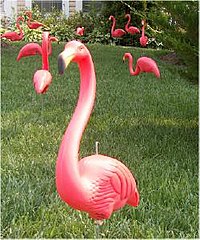| Plastic flamingo | |
|---|---|
 | |
| Artist | Don Featherstone |
| Year | 1957 |
| Type | Sculpture |
Pink plastic flamingos are a common lawn ornament in the United States.
History
Union Products
The American artist Don Featherstone designed the pink lawn flamingo in 1957, naming the first Diego. His lawn flamingo, mass-produced by his employer, Union Products, of Leominster, Massachusetts, has since become an icon of pop culture that won him the Ig Nobel Prize for Art in 1996. It has even spawned a spoof lawn greeting industry that installs flocks of pink flamingos on a victim's lawn in the dark of night. After the release of John Waters's 1972 movie Pink Flamingos, plastic flamingos came to be the stereotypical example of lawn kitsch.
Many imitation products have found their way onto front lawns and store shelves since then. Genuine pink flamingos made by Union Products from 1987 (the 30th anniversary of the plastic flamingo) until 2001 can be identified by the signature of Don Featherstone on the rear underside. These official flamingos were sold in pairs, one standing upright and the other with its head low to the ground, "feeding". Sometime after Featherstone's retirement in 2000, Union Products began producing birds without the signature. In December 2001, the Annals of Improbable Research (bestowers of the Ig Nobel prize) teamed up with the Museum of Bad Art to protest this omission in the form of a boycott. Union Products stopped production of pink flamingos on November 1, 2006.
HMC International LLC
HMC International LLC, a subsidiary of Faster-Form Corporation, purchased the copyright and plastic molds of Featherstone's original plastic flamingos in 2007. HMC sub-contracted production of the flamingos to Cado Manufacturing, Inc., a blow-molder located in Leominster, Massachusetts, who specialized in this type of production. In 2010, Cado Manufacturing purchased the copyrights and the entire Union Products product line, including the pink flamingo, from HMC.
In culture
In the media and fiction, plastic flamingos are often used as a symbol of kitsch, bad taste and cheapness. The movie Pink Flamingos is named after them and helped them become an icon of trash and kitsch.
In 2009, the city of Madison, Wisconsin, Common Council designated the plastic flamingo as the city's official bird. The city's soccer club, Forward Madison FC, uses the plastic flamingo on its logo.
Some homeowners associations forbid the installation of plastic flamingos and similar lawn ornaments, and will fine offending owners, on the basis that such decorations lower the neighborhood's real estate values.
In 2024, as a political statement, some homeowners painted their pink plastic flamingoes blue, to indicate support for Harris-Walz over Trump-Vance in the Presidential election. This was reported mainly in retirement communities in the southern US, where neighborhood associations often forbid the posting of political lawn signs.
See also
References
- ^ Collins, Clayton (2006). "Backstory: Extinction of an American icon?". Christian Science Monitor. Retrieved 2008-04-23. Published: November 2, 2006
- "Is the pink flamingo an endangered species?". NBC News. 2006. Retrieved 2008-04-23. Published: November 1, 2006. From the Associated Press
- Alice Shirrell Kaswell, AIR staff (2001-12-21). "Join the Plastic Pink Flamingo Boycott!". Annals of Improbable Research. Retrieved 2011-07-16.
- "Retro pink flamingos to hatch in New York". NBC News. 2007. Retrieved 2008-04-23. Published: May 31, 2007. From the Associated Press, on the purchase and re-production of Don Featherstone's original plastic-flamingo design.
- Rickert, Chris (2009-09-01). "City designates plastic pink flamingo as official city bird". Wisconsin State Journal. Retrieved 2009-09-03.
- "We Are Forward Madison FC". forwardmadisonfc.com. Forward Madison FC. November 18, 2018. Retrieved April 7, 2020.
'We also incorporated the Official Bird of Madison, the Pink Plastic Flamingo, which was also a popular name submission by the fans,' Wilt said.
- Beato, Greg (2008). "Garden gnome politics: the age-old battle over landscape expression". Cengage. Retrieved July 16, 2012.
- Pescovitz, David (2006). "Pink flamingos, RIP". BoingBoing. Archived from the original on 2007-03-14. Retrieved 2008-04-23. Published: October 19, 2006.
- Kaswell, Alice Shirrel (2001-12-21). "Join the Plastic Pink Flamingo Boycott!". Annals of Improbable Research. Retrieved 2011-07-16. Describes the change in design and calls for boycott.
- Price, Jenny (2006). "In the Pink No More". The New York Times. Retrieved 2008-04-23. Published November 17, 2006 - Reflects on the shutdown of the original plastic-flamingo factory and the flamingo's impact on popular culture.
- Featherstone, Don; Herzing, Tom (1999). The Original Pink Flamingos: Splendor on the Grass. Schiffer Publishing. ISBN 978-0-7643-0963-2.
External links
- [REDACTED] Media related to Plastic flamingos at Wikimedia Commons
- Lawn flamingo fansite
| Lawn and garden ornaments | ||
|---|---|---|
| Lawn |  | |
| Garden | ||